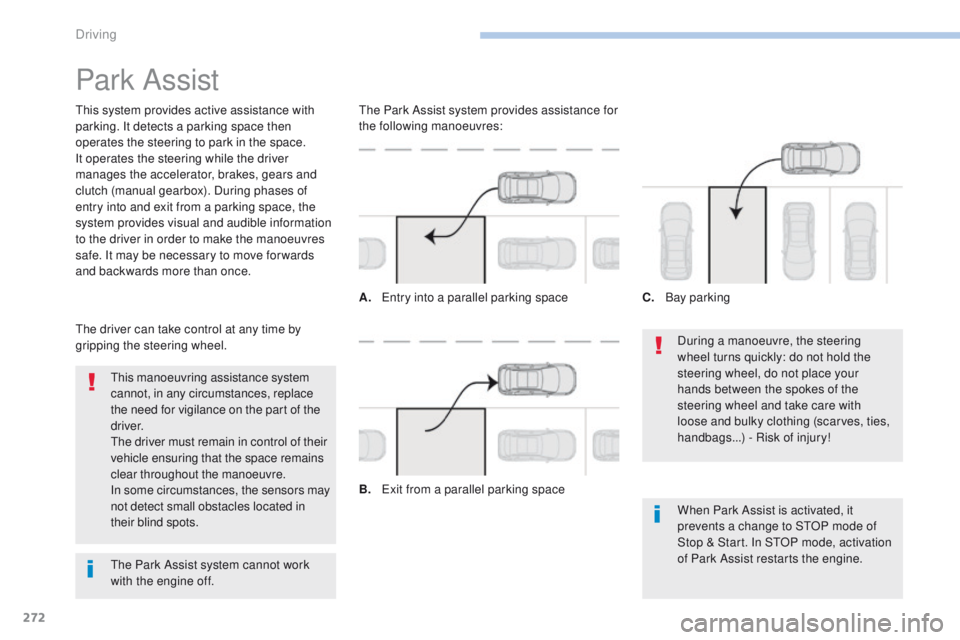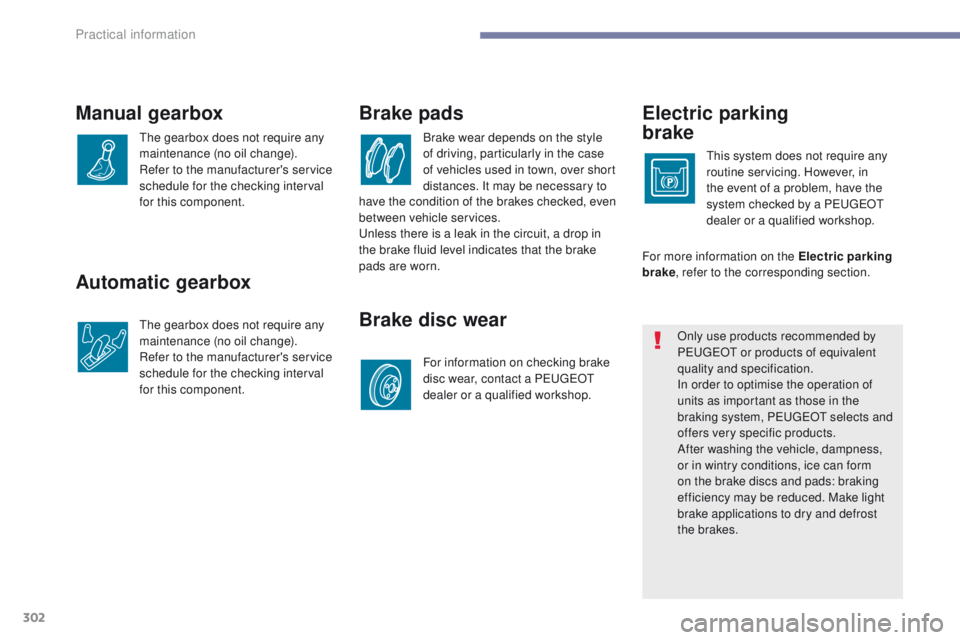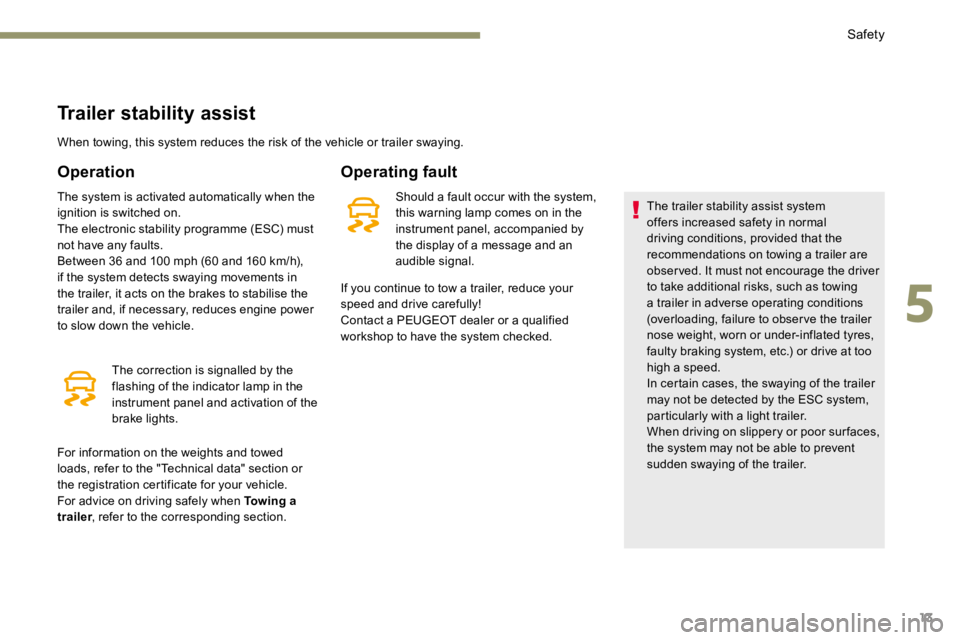2017 Peugeot 308 brakes
[x] Cancel search: brakesPage 251 of 566

249
3008-2_en_Chap06_conduite_ed01-2016
Modifying the alert trigger
threshold
This threshold determines how you wish to be
warned of the presence of a vehicle moving
or stationary in front of you, or a pedestrian
present in your traffic lane.
The current threshold can be modified via the
vehicle configuration menu in the screen.
You can select one of three thresholds:
- "Distant ",
-
"Normal ",
-
"Close ".
The last threshold selected is kept in memory
when the ignition is switched off.
Intelligent emergency
braking assistance
If the driver brakes, but not sufficiently to
avoid a collision, this system will complete the
braking, within the limits of the laws of physics.
This assistance will only be provided if you
press the brake pedal.
6
Driving
Page 252 of 566

250
3008-2_en_Chap06_conduite_ed01-2016
Active Safety Brake
This function, also called automatic emergency
braking, aims to reduce the speed of impact or
avoid a frontal collision by your vehicle where
the driver fails to react.
Using a radar and a camera, this function acts
on the vehicle's braking system.If the radar and the camera have
confirmed the presence of a vehicle
or a pedestrian, this warning lamp
flashes once the function is acting on
the vehicle's brakes.
Important
: if operation of the
automatic emergency braking is
triggered, you should take back
control of your vehicle and brake
with the pedal to add to or finish the
automatic braking action.
The driver can take back control of the vehicle
at any time by sharply turning the steering
wheel and/or pressing the accelerator pedal. Operation of the function may be felt by
slight vibration in the brake pedal.
If the vehicle comes to a complete stop,
the automatic braking is maintained for
1 to 2 seconds.
With a manual gearbox, in the event
of the automatic emergency braking
bringing the vehicle to a complete stop,
the engine may stall.
With an automatic gearbox, in the event
of the automatic emergency braking
bringing the vehicle to a complete stop,
keep the brake pedal pressed to stop
the vehicle moving off again.
The point at which braking is triggered
may be adjusted according to the
reaction from the driver, such as
movement of the steering wheel or
pressing the accelerator pedal.
Driving
Page 257 of 566

255
3008-2_en_Chap06_conduite_ed01-2016
Assisted Lane Departure Warning System
Using a camera placed at the top of the windscreen to identify lane markings on the ground, this system corrects the trajectory of the vehicle while
alerting the driver if it detects a risk of involuntary crossing of a line.
This system is particularly useful on motor ways and main roads.
Conditions for operation
The speed of the vehicle must be between 40
and 112 mph (65 and 180 km/h).
The carriageway must have at least one lane
marking (solid or broken) on the ground.
The driver must hold the wheel with both
hands.
The change of trajectory is not accompanied by
operation of the direction indicators.
The ESC system must be activated.This system is a driving aid which
cannot, in any circumstances, replace
the need for vigilance on the part of the
driver.
The driver remains responsible for the
vehicle in all circumstances. The system
helps the driver only when there is a risk
of the vehicle involuntarily wandering
from the lane it is being driven on.
It does not manage the safe driving
distance, the speed of the vehicle or the
brakes.
The driver must hold the steering wheel
in a way that allows control to be taken
back in circumstances where the system
is not able to intervene (where there are
no lane markings, for example).
It is necessary to observe the driving
regulations and take a break every
two
hours.
6
Driving
Page 274 of 566

272
3008-2_en_Chap06_conduite_ed01-2016
Park Assist
This system provides active assistance with
parking. It detects a parking space then
operates the steering to park in the space.
It operates the steering while the driver
manages the accelerator, brakes, gears and
clutch (manual gearbox). During phases of
entry into and exit from a parking space, the
system provides visual and audible information
to the driver in order to make the manoeuvres
safe. It may be necessary to move for wards
and backwards more than once.During a manoeuvre, the steering
wheel turns quickly: do not hold the
steering wheel, do not place your
hands between the spokes of the
steering wheel and take care with
loose and bulky clothing (scarves, ties,
handbags...) - Risk of injury!
When Park Assist is activated, it
prevents a change to STOP mode of
Stop & Start. In STOP mode, activation
of Park Assist restarts the engine.
This manoeuvring assistance system
cannot, in any circumstances, replace
the need for vigilance on the part of the
driver.
The driver must remain in control of their
vehicle ensuring that the space remains
clear throughout the manoeuvre.
In some circumstances, the sensors may
not detect small obstacles located in
their blind spots.
The driver can take control at any time by
gripping the steering wheel. The Park Assist system provides assistance for
the following manoeuvres:
A.
E
ntry into a parallel parking space
B.
E
xit from a parallel parking spaceC.
B
ay parking
The Park Assist system cannot work
with the engine off.
Driving
Page 304 of 566

302
3008-2_en_Chap07_infos-pratiques_ed01-2016
Automatic gearbox
The gearbox does not require any
maintenance (no oil change).
Refer to the manufacturer's service
schedule for the checking interval
for this component.
Electric parking
brake
This system does not require any
routine servicing. However, in
the event of a problem, have the
system checked by a PEUGEOT
dealer or a qualified workshop.
Brake pads
Brake wear depends on the style
of driving, particularly in the case
of vehicles used in town, over short
distances. It may be necessary to
Brake disc wear
For information on checking brake
disc wear, contact a PEUGEOT
dealer or a qualified workshop.For more information on the Electric parking
brake
, refer to the corresponding section.
Manual gearbox
The gearbox does not require any
maintenance (no oil change).
Refer to the manufacturer's service
schedule for the checking interval
for this component.
Only use products recommended by
PEUGEOT or products of equivalent
quality and specification.
In order to optimise the operation of
units as important as those in the
braking system, PEUGEOT selects and
offers very specific products.
After washing the vehicle, dampness,
or in wintry conditions, ice can form
on the brake discs and pads: braking
efficiency may be reduced. Make light
brake applications to dry and defrost
the brakes.
have the condition of the brakes checked, even
between vehicle services.
Unless there is a leak in the circuit, a drop in
the brake fluid level indicates that the brake
pads are worn.
Practical information
Page 348 of 566

346
3008-2_en_Chap11_index-alpha_ed01-2016
180° rear vision .............................................2 67Air intake .......................................................111
Air vents ........................................................104
Alarm
...............................................................70
Amplifier, audio
.............................................12 2
Anti-lock braking system (ABS)
......................................16
0, 161
Anti-theft
.......................................................197
Armrest, front
................................................124
Armrest, rear
................................................. 13
4
Assistance call
..............................................15 8
Assistance, emergency braking
...............
.................................160, 249
Audio system (r adi o)
............................................................45
C
Capacity, fuel tank .............................. ..........281
Cartridge, fragrance .............................125, 126
Central locking
.......................................... 60, 68
Changing a bulb
........................... 323, 328 , 330
Changing a fuse
............................................ 331
Changing a wheel
......................................... 309
Changing a wiper blade
................................15 4
Changing the remote control battery
........................................................... 66
C
harger, induction
......................................... 12 2
Charger, wireless
.......................................... 12 2
CHECK
................
............................................ 40
Checking the engine oil level
.......................................................... 36
Checking the levels
...............................2 97- 3 0 0
Checking tyre pressures (using the kit)
..............................
................312
Checks
...............
..................295, 296 , 301, 302
Checks, routine
..................................... 301, 302
Child lock
...............................
................193, 19 4
Children
...............................
..18 4 , 18 6 -188 , 19 0
Children (safety)
...............................
.....193 , 19 4
Backrest, folding
............................................. 92
Battery
................................... 290, 301 , 332-335
Battery, charging
........................................... 334
Battery, remote control
............................. 63,
66
Blanking screen
(snow shield)
...............................
................ 291
Blind
................................................................ 84
Blind spot monitoring system
......... 20, 260 , 262
Blind spot monitoring system, active ..................................................... 20, 262
Blind spot sensors
.................................. 20, 260
BlueHDi
..................................... 37, 40 , 303 , 308
Bonnet
........................................................... 294
Boot
..................................................... 75, 76 , 79
Brake discs
.................................................... 3
02
Brake lamps
.................................................. 328
B
Brakes ..................................................... 26, 302
Braking assistance system
......................................................... 160
Braking, automatic emergency
.............................. 21, 26 , 247 , 250
Braking, dynamic emergency
......................................... 203, 208
Bulbs (changing)
.......................... 32
3, 328 , 330
Accessories
.......................................... 15 6, 201
Active Safety Brake................... 21, 26 , 247 , 250
AdBlue
® ..................................... 3 0, 37 , 303 , 304
Additive, Diesel ............................................. 301
Adjusting headlamps
.................................... 145
Adjusting head restraints
................................ 93
Adjusting seat
..................................... 90, 91 , 94
Adjusting the air distribution
.........................111
Adjusting the air flow
..................................... 111
Adjusting the date
........................................... 45
Adjusting the height and reach of the steering wheel
.................................... 99
Adjusting the lumbar support
..............90, 91 , 94
Adjusting the seat belt height
.......................168
Adjusting the temperature
............................ 111
A
djusting the time
........................................... 45
Advanced Grip Control
................................. 16 4
Advice on driving
.................................. 195, 19 6
Airbags
.................................................... 28, 172
Airbags, curtain
..................................... 17
5, 176
Airbags, front ......................................... 173, 176
Airbags, lateral
...................................... 175, 176
Air conditioning
................................ 10, 107 , 11 0
Air conditioning, automatic
...........................105
Air conditioning, digital
.......................... 111, 11 6
Air conditioning, dual-zone automatic
............................................. 111,
11 6
Air conditioning, manual
...............105, 10 6 , 11 6
Air conditioning, mono-zone
.................108, 11 6
A
Alphabetical index
Page 553 of 566

13
Trailer stability assist
When towing, this system reduces the risk of the vehicle or trailer swaying.
Operation
The system is activated automatically when the
ignition is switched on.
The electronic stability programme (ESC) must
not have any faults.
Between 36 and 100 mph (60 and 160 km/h),
if the system detects swaying movements in
the trailer, it acts on the brakes to stabilise the
trailer and, if necessary, reduces engine power
to slow down the vehicle.The correction is signalled by the
flashing of the indicator lamp in the
instrument panel and activation of the
brake lights.
Operating fault
Should a fault occur with the system,
this warning lamp comes on in the
instrument panel, accompanied by
the display of a message and an
audible signal. The trailer stability assist system
offers increased safety in normal
driving conditions, provided that the
recommendations on towing a trailer are
obser ved. It must not encourage the driver
to take additional risks, such as towing
a trailer in adverse operating conditions
(overloading, failure to obser ve the trailer
nose weight, worn or under-inflated tyres,
faulty braking system, etc.) or drive at too
high a speed.
In certain cases, the swaying of the trailer
may not be detected by the ESC system,
particularly with a light trailer.
When driving on slippery or poor sur faces,
the system may not be able to prevent
sudden swaying of the trailer.
If you continue to tow a trailer, reduce your
speed and drive carefully!
Contact a PEUGEOT dealer or a qualified
workshop to have the system checked.
For information on the weights and towed
loads, refer to the "Technical data" section or
the registration certificate for your vehicle.
For advice on driving safely when Towing a
trailer , refer to the corresponding section.
5
Safety
Page 554 of 566

14
Distance alert and Active Safety Brake
This system includes three functions:
- Distance alert (alert if there is a risk of
collision),
- Intelligent emergency braking assistance,
- Active Safety Brake (automatic emergency
b r ak ing).
Distance alert: it warns the driver if their
vehicle is at risk of collision with the vehicle in
front or a pedestrian present in their traffic lane.
Intelligent emergency braking assistance :
it supplements the braking action taken by the
driver if this is inadequate.
Active Safety Brake: it intervenes following
the alert if the driver does not react quickly
enough and does not operate the vehicle's
brakes.
If the driver fails to act, it contributes
towards avoiding a collision or limiting
its severity by reducing the speed of your
vehicle.
Activation and operating conditions
The vehicle has a camera located at the top of
the windscreen, and depending on the version,
a radar located in the front bumpers.
The system is activated from about 4 mph
(7 km/h) and is deactivated below about 3 mph
(5 km/h).
It takes account of:
- registered vehicles running in the same
direction or stationary,
- pedestrians in the traffic lane (bicycles,
motorcycles, animals and objects on the
road are not necessarily detected). This system is designed to assist the
driver and improve road safety.
It is the driver's responsibility to
continuously monitor the state of the
traffic, observing the driving regulations.
This system does not replace the need for
vigilance on the part of the driver.
Driving